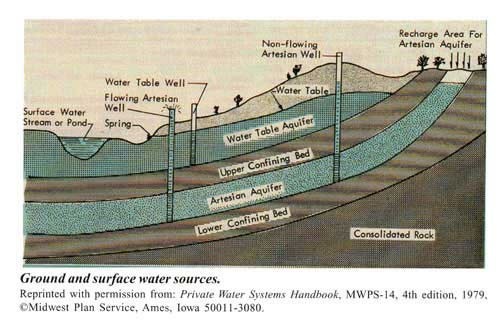― WATER SUPPLY ―
All watershed residents need a clean source of water for everyday life. The lake and groundwater are the principle sources of drinking water. A properly constructed and maintained water system supplies an adequate quantity of potable water year round. It delivers water at a rate that meets the temporary large demands that occur each day, and provides enough water to fight small fires. Typical water needs for a variety of uses are listed in Table 1.
Groundwater is water in pore spaces of sand and gravel deposits or cracks found in bedrock. Precipitation that falls to the earth and soaks through the soil into permeable subsurface areas usually create the safest and most reliable drinking water sources. Lakes, streams, and rivers that make up surface waters are not recommended sources for drinking water unless first filtered and disinfected.
Tapping Groundwater
Many people in the United States use a well to supply their drinking water. A well taps into groundwater which is pumped to the surface. The different types of wells are named for their method of construction. There are five common types of wells: dug, bored, driven, jetted and drilled. Dug, bored, jetted, and driven wells are very seldom more that 50 feet deep. Drilled wells, on the other hand, are often 75' - 300' deep. See Table-2 for a description of each type of well.
When designing or reclaiming a well, there are several sanitary measures recommended to prevent future contamination and protect the water users.
- Make sure the casing of the well extends at least 12 inches above the ground surface and above any know flood level. For existing wells, find out if it has ever been flooded.
- Check that the casing has a water-tight cover to prevent anything from getting into the well.
- For existing wells, take off the cap and look down the well. Make sure that the casing, cap, and seal are free of cracks, holes, etc...
- Check that the ground or grout is tight against the casing.
- Make sure the ground slopes away from the casing on all sides, so that water cannot pond around the well and run down the casing.
- Check that the air vent pipe (if visible) is screened and faces down to prevent insects and rain from entering.

Commercially Dug Wells
If you plan to have a well constructed, make sure to have a written contract between yourself and the well-driller. A written agreement can help avoid costly misunderstandings. The contract should describe the work to be done, the cost and terms of payment, and should also include:
- Statement that all work is to comply with existing county and state well codes;
- Size of well hole and methods of eliminating surface contamination;
- Casing specifications - i.e., the casing is to be at least 4 inches in diameter and extend at least 25 feet below the ground surface;
- Type of well seal and grout seal around the casing;
- Type of screen to be installed, where needed;
- Test-pumping procedure to be used;
- Disinfection procedure to be used;
- Date for completion of well and delivery of well log and test-pumping report;
- Guarantee of materials and workmanship;
- Cost-an itemized list including cost of drilling per foot, charges for other materials per unit, and charges for other operations such as grouting, developing, and test-pumping;
- Liability insurance for owner and driller.
Siting a Well
A well should provide adequate water for family needs and be protected from contamination. While local and state codes require proper siting and construction for an onsite wastewater treatment system, they do not have specifications for siting a drinking water supply. New York does not regulate the siting of a well, but they do give recommendations for its location. These guidelines specify the minimum distance between obvious sources of contamination such as wastewater systems, road salt storage piles, underground gasoline tanks, fertilizer or pesticide storage areas or landfills. In general, a well should be located in an area higher than and 200 feet away from any potential source of pollution. See Table-3 for these separation distances. The recommended setback distances help ensure that that natural filtration capacity of the soil is capable of removing contaminants from groundwater. This filtering action is dependent on the type of material through which the water moves; little filtration occurs in limestone or fractured shale. In certain types of soil such as gravelly outwash soils found in stream valleys, the distances between the drinking water supply and the wastewater treatment system should be more than the state's minimum recommendation.
Well Abandonment
Unsealed, abandoned wells are potentially hazardous to children and pets who may fall into them. They are also a potential pathway for groundwater contamination. Abandoned wells should be filled with concrete, cement grout, or clay material. A dug or bored well should have as much of the lining removed as possible to prevent surface water from reaching the underlying aquifer through cracks or openings in the lining material. If the well cannot be filled in this manner, it should at least be tightly capped. Abandoned wells should never be used for waste disposal.
Well Maintenance
The area around a well should be protected from animals, chemicals, and any activity that might contaminate groundwater. Before it is first used, and anytime following work on it, the well should be disinfected by shock chlorination. For information on shock chlorination see Failed Bacteria Tests in Chapter 3: Water Testing and Treatment. If bacteriological problems persist following shock chlorination, a continuous chlorination system or other method of bacteriological treatment should be used.
Well water should be tested annually for coliform bacteria and nitrate and any other potential contaminants determined by activity near the well or more distant activities occurring in the aquifer recharge area. Iron, manganese, hydrogen sulfide, and hardness are frequently associated with groundwater supplies, but are not considered to be health hazards. Treatment for these problems are available and your local Cornell Cooperative Extension office or health department office can usually provide information about treatment options.
A well may fail to provide an adequate supply of water due to a faulty pump, decline in water level, plugged or deteriorated screens, or an accumulation of sand or sediments in the well. A well driller or Cornell Cooperative Extension agent can help determine the cause of failure and provide information concerning possible remedies. When consulting the experts about troubles with the water supply, you need to know the details of your system.
Drinking Surface Water
According to a 1996 KLA survey, 58% of people living along the lake use the lake as a source of drinking water. Many people do not use a disinfection system to kill bacteria, even though water from lakes, streams, ponds and creeks are "open" systems and subject to contamination. Summer water samples from around the lake have at times, shown high fecal bacteria numbers. These results confirm that while Keuka Lake is clean most of the time, there are days when the water would be considered unpotable and therefore should be continuously disinfected.

